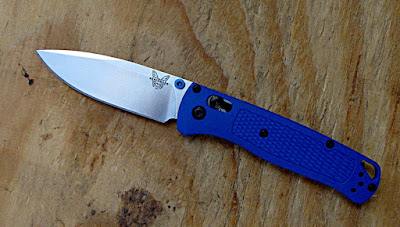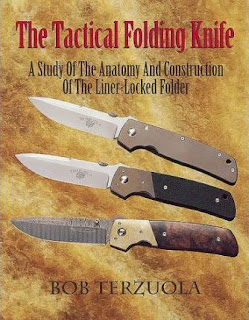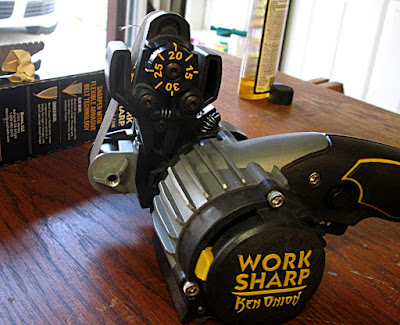In this corner we have Benchmade’s Anthem and in the
opposite corner we have Benchmade’s Bugout.
All right, I want a clean fight.
No clip gouging, no biting and no hitting below the axis lock. Okay?
Now go to your corners and come out on the bell.
Bonggggg!
This is an unfair fight.
But let’s see how it shakes out.
The Anthem is a manual opener with Benchmade’s famous AXIS
lock. Introduced in 2017, its unique
feature is the handle is machined out of a solid billet of titanium. For the same strength, titanium is 45%
lighter than steel. So this knife weighs
in at 3.66 ounces. The titanium handle
is sculpted in a chevron pattern that is pleasing to the touch and attractive
to the eye. The knife is set up for tip
up carry and the titanium clip is left/right reversible.
 |
| Hey, good looking... |
As soon as anyone uses the term wonder steel, a new one
appears on the horizon. Still it is the
correct adjective to describe this steel.
Let’s talk composition.
20CV is a martensitic steel containing 1.9% carbon, 20%
chromium and a whopping 4% vanadium with 1% molybdenum and a smidge of
tungsten. The high concentration of
carbon and vanadium produces a high volume of incredibly hard vanadium
carbides. These carbides strengthen the
steel and give it wear resistance which benefits any knife blade. The chrome rich steel has excellent corrosion
resistance.
Starting as a powder steel 20CV has small grain and uniform
distribution of tiny carbide grains. But
machining is difficult, having only 35-40 percent of the machinability of 1%
carbon steel. Hardening, annealing,
tempering operations are complex and time consuming. Despite these complications the Anthem’s
blade reaches 59-61HRC.
 |
| The screws in the spine anchor the AXIS lock |
The opening stud is easy to find and is spaced nicely from
the body allowing easy access. The blade
glides open on what looks like bronze washers.
It’s a beautiful knife.
If I had to summarize Benchmade’s Bugout, I would have to say:
“Now for something completely different!”
I also have to add different isn’t bad.
The Bugout was introduced this year, 2018. It too is a manual opener with an AXIS
lock. It’s thinner, lighter and more
compact than the Anthem. The steel is
CPM S30V, another super steel.
S30V is a martensitic steel containing 1.4% carbon, 14%
chromium and also 4% vanadium with 2% molybdenum. The rest of course is iron. Vanadium reacts with carbon to produce very
hard carbides. Harder than chromium
carbide. Generally, steel has to contain
10.5 % chromium to be considered stainless.
One factor to consider in this equation is how much of the chromium is
removed from the metal as carbides.
Fortunately, as chemical reactions go, vanadium carbides are the favored
product, so most of the chromium is available for protection from oxidation or
staining.
 |
| A nice Introduction to Benchmade quality knives. |
Powdered metal products, in general, have smaller grain size
and a better distribution of the carbides than cast steel. It’s reported to be as easy as D2 steel to
machine, which according the fount of all knowledge, Wikipedia, isn’t all that
easy.
Hardening, annealing, tempering operations seem to be
relatively straight forward. Bugout’s
blade reaches 58-60HRC.
The handle is a glass fiber filler nylon called
Grivory. It one of many types of
engineering nylons and its properties are well understood. There will not be any surprises here.
The knife is set up for tip up and the metal clip is reversible
left/right and set up for deep pocket carry.
 |
| You can see the steel liner ending just at the top finger. there's a second one on the other side. |
The knife doesn’t have full handle metal liners. The metal liner is about 1.7 inches long and
it looks like it’s injection molded into the handle and then screwed at the
tail end for additional strength. The
opening stud has a nice blue color but it’s held near to the grip making the
knife a little more difficult to open as compared to the Anthem. The AXIS lock is also tucked into the handle
and the blade doesn’t swing free when the AXIS lock is used as does the Anthem.
As Gin Wigmore says “going head to head”:
|
Property
|
Bugout
|
Anthem
|
|
Steel
|
CPM S30V
|
CPM-20CV
|
|
Handle Material
|
Grivory
|
Titanium Billet
|
|
Blade Hardness
|
58-60 RHC
|
59-61 RHC
|
|
Blade Length
|
3.24 inches
|
3.5 inches
|
|
Closed Length
|
4.22 inches
|
4.56 inches
|
|
Lock System
|
AXIS
|
AXIS
|
|
Weight
|
1.85 oz.
|
3.66 oz.
|
|
Clip
|
Reversible – deep
carry
|
Reversible
|
|
Orientation
|
Tip Up
|
Tip Up
|
|
CATRA Edge
Retention
|
145% of 440C
|
180% of 440C
|
|
Cost
|
$135 MSRP
|
$500 MSRP
|
CATRA edge testing is one of the new witchcraft testing
procedures to produce a reproducible, operator independent, meaningful edge
retention value. The problem with many
of these types of test is finding a test material that is also constant and
reproducible. In any case it’s better
than you and buddy shaving leather or cutting steaks.
So, what do I think?
These are knives designed for different needs and different people.
The Bugout is a nice “Welcome to Benchmade” knife. It’s small and compact but provides enough
cutting ability for most uses. It’s the
knife I would carry in places I couldn’t carry a knife. Places I thought I might lose a knife. If I was packing a true hell-for–leather
bugout bag, one of the knives would be a Bugout. If I was going to stash a knife, a couple
hundred in twenties, compass and matches in a sealed wax container… you get the
idea.
The Anthem, well, it a great knife and for me it would a “barbecue”
knife. Something I’d pull out of my
pocket to show off. I’d carry it in
places where I never intended to use a knife.
It would be a status symbol for me, if I used those kinds of status
symbols. But look, if you need to get
the most out of a knife, if you use a blade hard and need every possible
advantage of edge, weight and durability, the Anthem could be your answer. It’s pricey, but I think it would hold up
better than the Bugout to hard, brutal use.

























